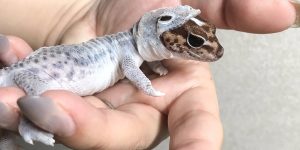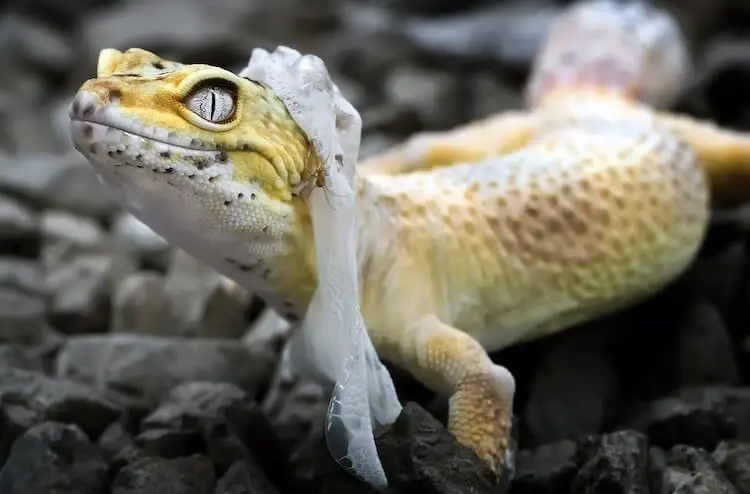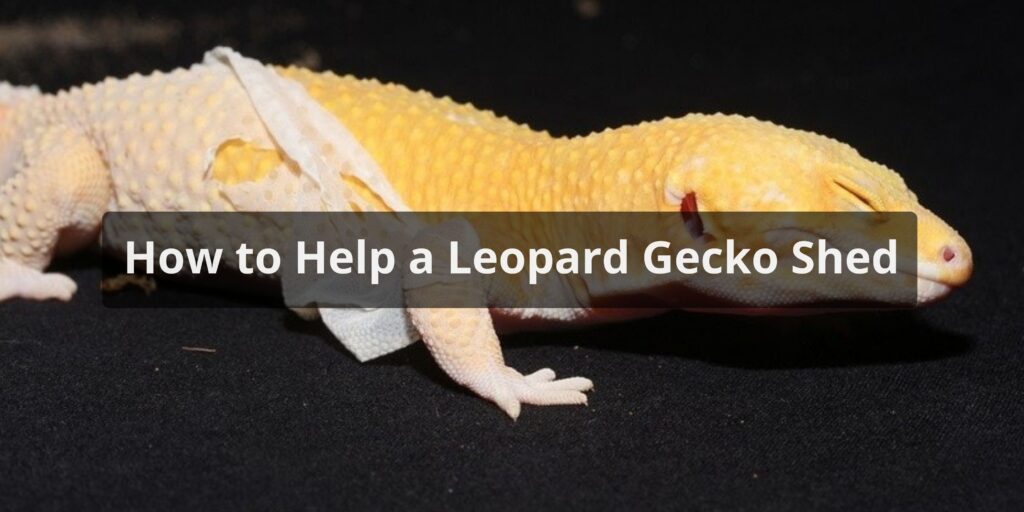Shedding is a natural process for leopard geckos where they slough off their old skin to make way for new skin growth underneath. This usually occurs every 4-8 weeks as the gecko grows. While shedding is normal, sometimes geckos can have trouble getting all of the old skin off on their own and may need some assistance how to help a leopard gecko shed. Here’s a guide on how to help a leopard gecko shed properly.
Signs Your Leopard Gecko is Ready to Shed

- Skin takes on a dull, whitish hue. The colors will look faded.
- Eyes appear cloudy or blue-grey colored.
- Behavior changes such as hiding more or not eating.
- Skin may appear bumpy or dry.
- Pieces of skin beginning to peel off.
These signs indicate the next shed is coming within a few days or up to about one week. Be on the lookout for when it starts to help the process go smoothly.
Ways to Assist the Shedding Process

Increase Humidity in the Enclosure
Having the proper humidity level in the tank is crucial for easy sheds. The ideal range for leopard geckos is between 40-60%. Some ways to raise humidity include:
- Using a humid hide – Place a hide or cave with damp moss for the gecko to crawl inside. Keep one side of the hide dry.
- Mist the enclosure using a spray bottle a few times per day. Avoid spraying directly on the gecko.
- Use a humidifier in the room if conditions are very dry. Monitor the tank humidity.
Having too high of humidity can also be problematic, so find the right balance.
Provide a Shedding Box
A dedicated shedding box with a textured surface can assist your leopard gecko in rubbing off the skin. You can use something like reptile carpet, terry cloth, or burlap fabric inside a plastic hide. Dampen it lightly and place in the warm side of the tank.
Give Warm Soaks
Giving a leopard gecko a soak in shallow, lukewarm water can help loosen stuck shed. Make sure the water only comes up to about the gecko’s belly area and keep the soak time to 10-15 minutes. Do this daily as needed until all the skin comes off.
Increase Tank Temperature
Bumping up the temperature a few degrees on the warm side can aid shedding. Ideal is 88-92°F. A temperature drop can delay shedding. Just make sure not to overheat the tank.
Apply Moisture with Q-tip
For small areas of lingering skin, you can gently rub with a cotton swab soaked in lukewarm water. Avoid pulling at it harshly. Go slowly and stop if the gecko seems stressed. The moisture helps loosen it up.
Use Reptile Shedding Aid Spray
Special shedding sprays are made just for helping reptiles shed. These can be spritzed on areas of stuck skin to help emulsify it for easy removal. Follow product directions.
Increase Healthy Fats
Make sure feeder insects are gutloaded with nutrients like calcium and healthy fats. This promotes smooth shedding. Feed a variety of insects.
See a Vet
If you’ve tried these steps and your leopard gecko still has retained shed, it likely needs veterinary assistance. Skin that stays stuck can constrict blood flow and cause health issues. A vet can safely remove the shed and treat any underlying problems.
What to Avoid

When dealing with a stuck shed, there are some things you shouldn’t do which could harm your leopard gecko:
- Don’t pick or pull at the skin – This can tear the skin or injure your gecko.
- Avoid using oil or ointments to try and loosen the skin. These can be toxic if ingested.
- Don’t give full immersion baths. Just shallow soaking is safer.
- Don’t over-handle the gecko if it seems stressed. Give breaks between treatments.
- Avoid too much moisture which can cause respiratory illness.
- Don’t use abrasive scrubbing tools or brushes.
Shedding is part of a healthy leopard gecko’s life. With the right environment and some help when needed, you can keep the shedding process smooth for your reptile friend. Pay attention to the signs of an oncoming shed and act quickly if it appears your gecko is having issues getting the skin off on its own. Proper handling can relieve discomfort and prevent complications. With some TLC and patience, your leopard gecko will be able to slither out of that old skin and continue thriving.
FAQs About How to Help a Leopard Gecko Shed
Can I assist my gecko in shedding if it’s struggling?
It’s possible to help your gecko if it’s having difficulty shedding. Create a humid environment by misting its enclosure and providing a moist hide with damp moss or paper towels. Avoid forcibly removing the skin; instead, let your gecko navigate the process naturally. If problems persist, consult a vet.
What is the best way to provide a shedding hide for geckos?
A shedding hide can aid your gecko’s shedding process. Use a small container with a snug entrance, filled with damp sphagnum moss or paper towels. Ensure it’s placed in a warm part of the enclosure. This provides a humid microclimate that helps soften and remove the old skin during shedding.
Are there any common shedding problems to watch out for?
Keep an eye out for issues during shedding, such as retained shed skin on toes, tail, or eyelids. These can lead to circulation problems or eye irritation. Dehydration, stress, or improper humidity levels may cause shedding problems. Regularly inspect your gecko during shedding to address any concerns promptly.
Should I remove the old skin if my gecko doesn’t eat it?
Leopard geckos often consume their shed skin, which is generally safe and provides nutrients. If your gecko doesn’t eat it, don’t worry; it’s not essential. However, if you notice persistent refusal to eat or signs of poor health, consult a vet to rule out underlying issues.
What post-shed care is needed to ensure my gecko’s health?
After shedding, ensure your gecko’s health by maintaining proper husbandry. Monitor for any retained shed skin or signs of stress. Provide fresh water and a well-balanced diet. Check the overall condition of your gecko’s skin and consult a vet if you notice any abnormalities or health concerns.



